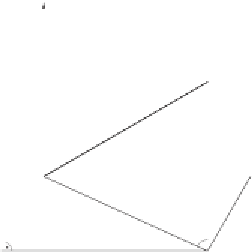Geoscience Reference
In-Depth Information
columns in the matrix of this equation system. Thus, we obtain
u
w
√
u
2
+
E
2
1
w
γ
x
=
cos
β
cos
λγ
u
−
sin
β
cos
λγ
β
−
sin
λγ
λ
,
u
w
√
u
2
+
E
2
1
w
γ
y
=
cos
β
sin
λγ
u
−
sin
β
sin
λγ
β
+cos
λγ
λ
,
(6-17)
1
w
u
w
√
u
2
+
E
2
γ
z
=
sin
βγ
u
+
cos
βγ
β
.
This follows from the definition of these coecients as direction cosines.
Equations (6-17) may also be found by solving the linear Eqs. (6-16) with
respect to
γ
x
,γ
y
,γ
z
in some other way.
The formulas of the present section are completely rigorous. They can
easily be programmed. Here it would not be appropriate to use the spherical
approximation because they are relatively large quantities of the normal
ellipsoidal field.
6.3
Gravity disturbance vector from gravity
anomalies
In Sect. 1.4, we have introduced spherical coordinates:
r
(radius vector),
ϑ
(polar distance),
λ
(geocentric longitude) (see Fig. 1.3). Now we use these
coordinates again but replace the polar distance
ϑ
by its complement, the
geocentric latitude
ϕ
(Fig. 6.3). In analogy to (1-26), these spherical coor-
z
P
r
z
#
¸
'
y
x
y
x
Fig. 6.1. Spherical coordinates
r, ϕ
(or
ϑ
, respectively),
λ
and
rectangular coordinates
x, y, z





















